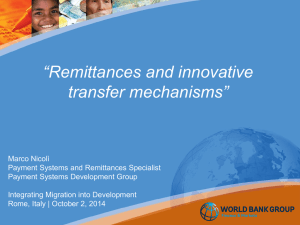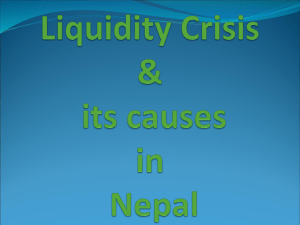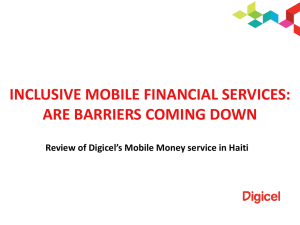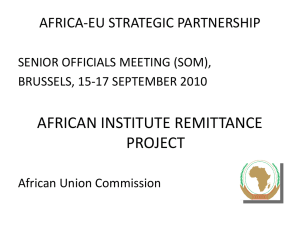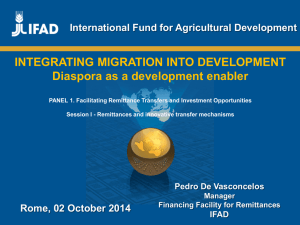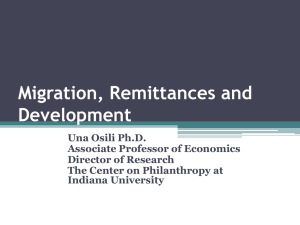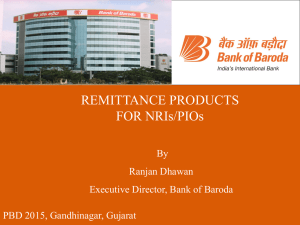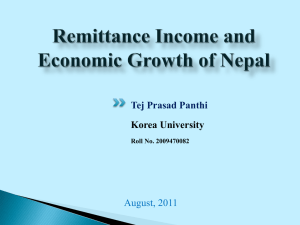WB-BIS General Principles for International Remittance Services
advertisement
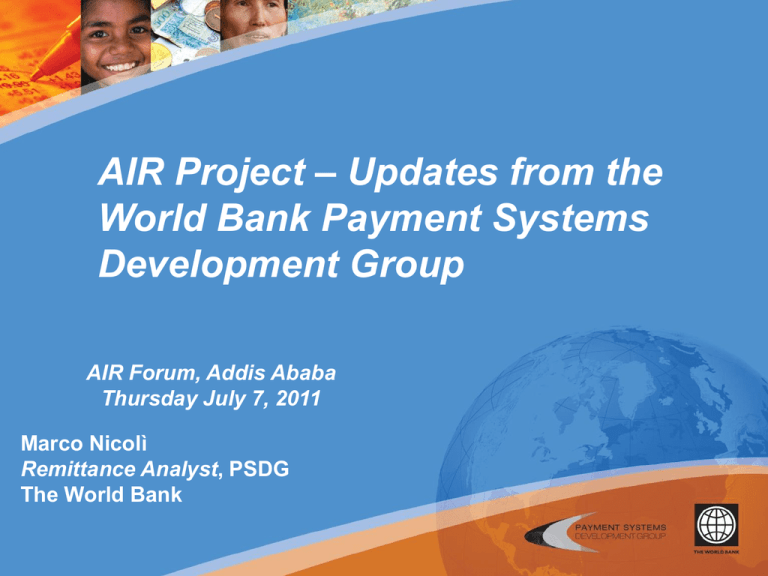
AIR Project – Updates from the World Bank Payment Systems Development Group AIR Forum, Addis Ababa Thursday July 7, 2011 Marco Nicolì Remittance Analyst, PSDG The World Bank Presentation structure The Role of the World Bank PSDG on Remittances The BIS-WB General Principles for International Remittance Services GPs Assessments of Remittance Markets in Tanzania and Malawi Send Money Africa: making remittances to Africa more transparent 2 The Role of the World Bank PSDG on Remittances 3 Payment Systems Development Group: Delivery Model The Payment System Development Group is at the center of an international network, whose main objective is supporting countries to reform Payments, Remittances, and SSS (over 120 countries in 14 years, 68 active!!!) API, CEMAC, CISPI, PAPRI World Bank Payment Weeks, SIBOS, Regional Events, International Conferences Develop Regional Initiatives SAPI, SADC, UEMOA, WHF Multilaterals and Standardsetters Knowledge Dissemination Payment Systems Development Group SWIFT, card networks, CLS Economic research on broad range of payment system issues including Bank, commercial banks, Research and New Developments Major Stakeholders remittances and new other financial institutions, payment system operators, vendors, at the global and technologies (mobile payments) CPSS, IMF, IFC IOSCO, Regional Development Banks other multilaterals Central Banks and SCs domestic levels G-10 and non G-10 Central Banks and Securities Commissions 4 PSDG Remittance Methodology WB-BIS General Principles for International Remittance Services 1. Assessment of and recommendations for concrete steps to improve national remittance market. \ 2. Technical Assistance for the implementation of the recommendations. Data Capture Legal Framework Technical Infrastructure Financial Access Market Structure Consumer Protection Oversight 3. Monitoring of remittance prices following the reforms. 5 General Principles for International Remittance Services - A Multilateral Effort to Address a Global Challenge Assessments: Lower costs, better performance, safer transfers Single country implementation with authorities and stakeholders Regional initiatives with regional partners Global Private-Public Sector Partnership Coordination group to develop implementation guidelines and monitor implementation Development of the General Principles Request from the International Community El Salvador (September 2006) Morocco (November 2006) Honduras (April 2007) Haiti (September 2007) Nigeria (February, 2008) Uganda (April 2008) Guatemala (April 2008) Czech Republic (May 2008) U.A.E (January 2009) Brazil (April 2009) T&T(October 2009) Peru (October 2009) Sri Lanka (May 2010) Rwanda (November 2010) Panama (December 2010) Paraguay (2011) Costa Rica (2011) Bangladesh (2011) Tanzania (April 2011) Malawi (May 2011) Nicaragua (June 2011) 6 Ongoing Initiatives Global Remittances Working Group: Continue work to reduce remittance costs in accordance with 5x5 objective G20 DWG: Lead the G20 action on international remittances and provide guidance for countries and International Organizations for the implementation of the General Principles African Institute for Remittances: Support African Union in the establishment of the institute and support various African countries with remittance reforms. Set up “Send Money Africa” remittance price database (coming soon in July 2011!!!) Rome Laboratory: Help countries to establish standards and the regulatory framework for new remittance services such as mobile payments Remittance Prices Worldwide Database: Keep monitoring prices of remittance services and ensure that the high cost of remittances stays on the policy agenda CEMLA: Technical support for countries in Latin America for the CEMLA Remittance Initiative ….and more…. 7 The BIS-WB General Principles for International Remittance Services An international remittance is a cross-border, person-to-person payment of relatively low value Typically by migrant workers to their families. Especially from developed to developing countries Person-to person, low value - ie not commercial or wholesale payments Domestic remittances also exist Recurrent - but typically made by individual transfers (eg not by standing order) For remittance service providers (RSPs), often indistinguishable from any other retail cross-border transfers 9 World Bank – CPSS General Principles for International Remittances Services GP1: The market for remittances should be transparent and have adequate consumer protection GP2: Improvements to payment system infrastructure that have the potential to increase the efficiency of remittance services should be encouraged GP3: Remittance services should be supported by a sound, predictable, non-discriminatory and proportionate legal and regulatory framework GP4: Competitive market conditions, including appropriate access to domestic payments infrastructures, should be fostered in the remittance service industry GP5: Remittance services should be supported by appropriate governance and risk management practices Remittance Service Providers Public Authorities Should participate actively in the application of the general principles Should evaluate what action to take to achieve the public policy objectives through implementation of the general principles 10 Premise is that best way to reduce cost is to have competition as far as possible The principles are not a call for remittances to be regulated. Sometimes it may be more important to remove existing regulation They do not aim to set specific service levels. Low price may often be more important than high level of service 11 Purpose is to tackle weaknesses in the market that inhibit competition (including poor regulation) Remittances are part of an individual’s access to financial services A good remittance product improves value to the user in the short term and access to other financial products in the long term There are no standard solutions 12 GP1: The market for remittances should be transparent and have adequate consumer protection Transparency means information about the service (price, speed, FX charge, etc). Transparency promotes competition and should drive down prices Especially important for remittances: “Access” problems for users Complex to work out price What is appropriate consumer protection? Most important are probably “error resolution” procedures (RSPs’ own or national schemes). Beware of the cost of some possibilities! 13 GP2: Improvements to payment system infrastructure that have the potential to increase the efficiency of remittance services should be encouraged Domestic payment infrastructure Remittance services usually depend to some extent on this. But the infrastructure may not always be very efficient, especially in receiving countries Cross-border payment infrastructure Greater standardisation to help STP in correspondent banking? Direct links between domestic systems as an alternative to correspondent banking? Linkages of different networks? 14 GP3: Remittance services should be supported by a sound, predictable, nondiscriminatory and proportionate legal and regulatory framework Does not mean special laws/regulations for remittances Sound, predictable, non-discriminatory… … and proportionate! Avoid danger of over-regulation. What is the problem regulation is meant to cure? Is regulation the best way to cure it? For key corridors, sending and receiving countries may want to cooperate if there seem to be legal obstacles 15 GP4: Competitive market conditions, including appropriate access to domestic payments infrastructures, should be fostered in the remittance service industry Importance of contestability and removing barriers to entry Avoid exclusivity conditions (as opposed to an agent choosing to offer only one remittance service) Are there problems with direct or indirect access to domestic payment systems? 16 GP5: Remittance services should be supported by appropriate governance and risk management practices RSPs face financial risk (eg if liquidity is supplied to disbursing agents), legal risk, operational risk, risk of fraud, reputational risk Good governance and risk management practices by RSPs make remittance services safer and help protect consumers… …but there is unlikely to be any systemic risk so protection measures should be proportionate to the risks 17 Who should take action? Many people may need to take action. But Remittance Service Providers and the authorities have particularly important roles: Remittance Service Providers should participate actively in the application of the general principles Public Authorities should evaluate what action to take to achieve the public policy objectives through implementation of the general principles • Form of action by authorities? Monitoring? Dialogue? Monitoring and outreach? Less interventionist Catalyst/ facilitator? Regulation? Direct provision? More interventionist 18 The General Principles have been formally endorsed by the G-8, G-20 and the Financial Stability Forum Both Sending and Receiving Countries have been urged to adopt them!!! 19 The Assessments of the Remittance Markets in Tanzania and Malawi How are the assessments performed • A preliminary research on available data and information on the country’s remittances market • A mission, generally one-week long • The mission team is composed by remittance experts or consultants of the PSDG • The mission team meets • • • • • • • • Central Bank Other local authorities including Ministries, Consumer Protection Agencies etc Commercial Banks, especially if targeting remittances market Post Office Money Transfer Operators Micro Finance Institutions Mobile Networks Operators Other Stakeholders • At the end of the mission, preliminary findings are presented to the authorities • Within a few weeks, a full assessment report is delivered to the authorities 21 Tanzania market overview /1 Data on remittance flows to and from Tanzania are scarce and inconsistent Source Inflows, 2009 (USD million) Outflows, 2009 (USD million) Bank of Tanzania (DERP) 16 54 Bank of Tanzania (DNPS) 332 138 African Development Bank 392 - If Tanzanian migrants remit an average of USD150 per month… 570 - Tanzania is most likely a net remittance receiving country There is a lack of information on the characteristics of these flows, in particular actual volumes and values of transactions, regional distribution, relevance of the non regulated market WB and IOM estimate that 317 thousands Tanzanians live abroad and 659 thousands foreigners reside in Tanzania Main destination countries are Kenya, Uganda, UK, Canada, Mozambique Top source countries are Burundi, Mozambique, Kenya, the Republic of Congo, Rwanda 22 Tanzania market overview /2 Remittance transfers Remittances transferred from and to Tanzania are generally between USD 200 and 500 per each transaction According to the World Bank Remittance Prices Worldwide database, the average total cost of sending USD 200 from Tanzania to East African countries is 23.6%, the highest in the world However, most transactions are performed through MTOs at an approximate total cost between 9% and 13% The great majority of remittances are collected and disbursed in cash REPORT DELIVERED! 23 Malawi market overview /1 There are no reliable and precise data on remittance flows to and from Malawi; most part of the flows are not reported in any official statistic WB estimate that 213 thousands Malawians live abroad (UK, US, South Africa) and 276 thousands foreigners reside in Malawi (Mozambique, Zambia, Zimbabwe); however, a large number of migrants might be unrecorded Some very approximate estimate on remittance flows can be attempted; If Malawians residing abroad sent home an average of USD 150 per month, the inflow would amount to about USD 32 million; other evidence suggest that the inflows could be around USD 45 million per year Malawi is a net remittance receiving country. All indicators confirm that most transactions are inward; however, due to limits in sending money through MTOs, it is also very likely that most outward low value transactions are channelled illegally or through non-regulated providers There is a lack of information on the characteristics of these flows, in particular actual volumes and values of transactions, regional distribution, relevance of the non regulated market 24 Malawi market overview /2 Remittance transfers Due to currency control, the maximum amount that can be sent through MTOs is USD 100. Higher amounts can be sent through banks (typically between USD 500 and 1000, often for education fees). There is no limit for inward transactions. Remittance transfers to Malawi are generally around USD 200. It is quite expensive to send money from South Africa to Malawi, with an average of 18.14 percent paid for sending the equivalent of USD 200 and 9.47 percent for sending the equivalent of USD 500. With some exception, there is no additional cost charged to the receiver. Nearly all remittances are collected and disbursed in cash. REPORT DRAFTING 25 Confidential Findings on the Tanzanian Remittances Market The market for remittances in Tanzania is dominated by XXXXXXXXXX,. This RSP holds the XX% of the market. The team recommends that the Bank of Tanzania XXXXXXXXXXX in the medium term in order to XXXXXXXXXXXXXXXXXXXXX The Tanzania Payment System Law should include a provision on XXXXXXX Commercial Banks in Tanzania XXXXXXXXXXX in the market. Confidentiality matters! The PSDG highly values confidentiality as an important instrument to build trust and obtain full and reliable information from both the national authorities and the market players. The Report is delivered to the local authorities and they are the only one to decide which information can be disclosed, if any. 26 National and Regional WB-certified databases Increasing the relevance and number of national databases on the cost of remittances because: They serve the ultimate beneficiaries of the remittances: the migrants They can cover more frequently the changes of the market They can serve as a benchmark for policy makers and the industry Send Money Africa 27 Send Money Africa /1 Potentially a reference point for African migrants to make informed decisions on the service they want to use to send money home A useful tool to identify critical areas of policy and business interventions and to increase competition and transparency in the market 50 country pairs, from Europe, North America and the Middle East to Africa, as well as intra-regional corridors Two amounts collected USD 200 and 500 Information on product types, transfer speed, network coverage and pick-up location in receiving country, fees, exchange rates applied, total cost, amount received in local currency, and more Mystery shopping techniques to ensure that information is collected from RSPs as if it was given to remitters 28 Send Money Africa /2 Sending Countries Receiving Countries Belgium D.R. of Congo, Morocco Canada Ghana, Kenya, Zimbabwe, France Algeria, Morocco, Ivory Coast, Mali, Senegal, Tunisia Germany Ghana, Morocco, Nigeria Senegal Mali Italy Ethiopia, Morocco, Nigeria, Senegal Kenya Uganda, Rwanda Netherlands Ghana, Morocco, Nigeria South Africa Angola, Botswana, Lesotho, Malawi, Mozambique, Swaziland, Zambia, Zimbabwe Spain Morocco Saudi Arabia Egypt Tanzania Kenya UAE Egypt UK Ghana, Kenya, Nigeria, Sierra Leone, Somalia, South Africa, Tanzania, Zimbabwe USA Cape Verde, Ethiopia, Ghana, Nigeria, 29 Send Money Africa will be launched on July 22 Help us spread the word!!! http://sendmoneyafrica.worldbank.org 30 THANKS! Marco Nicolì Remittance Analyst Payment Systems Development Group The World Bank mnicoli1@worldbank.org www.worldbank.org/paymentsystems http://remittanceprices.worldbank.org http://sendmoneyafrica.worldbank.org (coming soon, July 2011)
